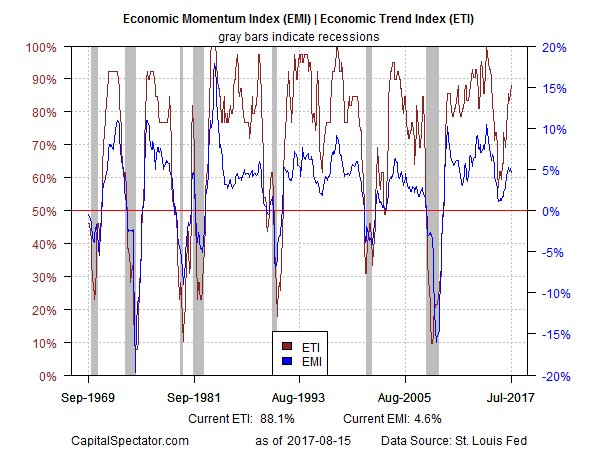The US economy continued to exhibit a moderate growth bias through July. Although the monetary backdrop still presents a mild headwind, the majority of key indicators published to date suggest that recession risk remains low.
Near-term projections of the macro trend also point to a low probability that the economy will suffer a dramatic deterioration. The eight-year-old US expansion, in short, still looks resilient at the moment.
Yesterday’s stronger-than-expected rise in retail sales for July supports the upbeat macro analysis. Spending jumped 0.6% last month, double the pace predicted by Econoday.com’s consensus forecast. “American shoppers flocked to the malls in July, suggesting consumers are well-positioned to propel the economy forward in the second half of the year,” said Sal Guatieri, an economist at BMO Capital Markets. “It should tamp down chatter about the Fed delaying rate hikes until next year.”
So, too, does yesterday’s upwardly revised estimate of third-quarter GDP growth from the Atlanta Fed’s GDPNow model. Supported by a firmer pace of retail spending last month, the bank’s Q3 nowcast increased to a strong 3.7% pace (seasonally adjusted annual rate) — solid improvement over Q2’s 2.6% advance. Now-casting.com’s 3.2% projection for Q3 GDP growth (as of Aug. 11) is almost as strong. Wall Street economists, however, continue to anticipate that Q3 output will be in line with the previous quarter. CNBC’s median survey data for Tuesday (Aug. 15) points to a fractional upgrade in Q3 growth to 2.8%. On the low end of estimates is the current forecast from the New York Fed, which is anticipating a mild slowdown in Q3 growth to 2.0% (Aug. 11).
Despite the wide range of Q3 projections, all four estimates underpin the current profile of low recession risk. The nearly complete profile for July shows only two instances of red ink in last month’s column of key indicators, which suggests that forward momentum continues to prevail. (For a more comprehensive review of the macro trend on a weekly basis, see The US Business Cycle Risk Report.)
Aggregating the data in the table above continues to a reflect a positive bias overall. The Economic Trend and Momentum indices (ETI and EMI, respectively) remain well above their respective danger zones (50% for ETI and 0% for EMI). When/if the indexes slide below those tipping points, the drops will mark clear warning signs that recession risk is elevated and a new downturn is likely. The analysis is based on a methodology that’s profiled in my book on monitoring the business cycle.
Translating ETI’s historical values into recession-risk probabilities via a probit model also points to low business-cycle risk for the US through last month. Analyzing the data in this framework indicates that the odds remain close to zero that NBER will declare July as the start of a new recession.
For perspective on what’s in store for the immediate future, consider how ETI may evolve as new data is published. One way to project values for this index is with an econometric technique known as an autoregressive integrated moving average (ARIMA) model, based on calculations via the “forecast” package for R. The ARIMA model calculates the missing data points for each indicator for each month — in this case through September 2017. (Note that May 2017 is currently the latest month with a full set of published data). Based on today’s projections, ETI is expected to remain well above its danger zone in the immediate future.
Forecasts are always suspect, but recent projections of ETI for the near-term future have proven to be reliable guesstimates vs. the full set of published numbers that followed. That’s not surprising, given ETI’s design to capture the broad trend based on multiple indicators. Predicting individual components, by contrast, is prone to greater uncertainty. The assumption here is that while any one forecast for a given indicator will likely be wrong, the errors may cancel out to some degree by aggregating a broad set of predictions. That’s a reasonable view, according to the generally accurate historical record for the ETI forecasts in recent years.
The current projections (the four black dots in the chart above) suggest that the economy will continue to expand. The chart above also includes the range of vintage ETI projections published on these pages in previous months (blue bars), which you can compare with the actual data (red dots) that followed, based on current numbers.
For more perspective on the track record of the forecasts, here are the previous business-cycle risk updates for the last three months:
19 July 2017
20 Jun 2017
19 May 2017
Note: ETI is a diffusion index (i.e., an index that tracks the proportion of components with positive values) for the 14 leading/coincident indicators listed in the table above. ETI values reflect the 3-month average of the transformation rules defined in the table. EMI measures the same set of indicators/transformation rules based on the 3-month average of the median monthly percentage change for the 14 indicators. For purposes of filling in the missing data points in recent history and projecting ETI and EMI values, the missing data points are estimated with an ARIMA model.




Pingback: Weighing the Week Ahead: Is a Market-Friendly Policy Agenda in Peril? – Dash of Insight
Pingback: Weighing The Week Ahead: Is A Market-Friendly Policy Agenda Now In Peril? - PakiMania
Pingback: Chicago Fed: US Economic Growth Is Close To Historical Trend – Tradebuddy.online Stockmarket news – Forex – News – Realtime market Data- World News – Trading Ideas
Pingback: Chicago Fed: U.S. Economic Growth Is Close To Historical Trend - PakiMania
Pingback: Market-Friendly Agenda in Peril? - TradingGods.net
Pingback: Japan, The Land Of The Rising ROE - iShares MSCI Japan ETF (NYSEARCA:EWJ) - PakiMania